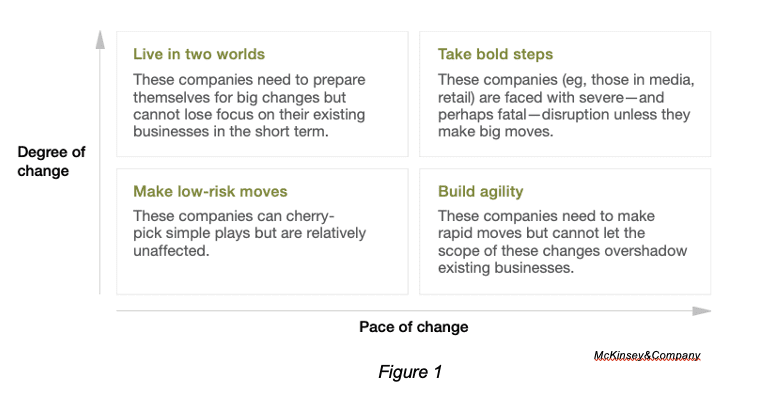
For Large SAP & Digital Transformational Programs, an essential consideration is: The Duality of Disruption
This Is the 2nd of a series of blogs discussing the Why, What and How (including the difficulties) of Large Transformational Programmes like SAP and Digital change.
As scene setters for these Transformations, the CEO and C-Suite spend most of their time and effort running and managing their current businesses (this includes digitising their current Business processes) in addition they must deal with the challenges of near-constant Change in their environments…. this is the Duality of Disruption.
Introduction
Digital disruption is a buzzword that has been circulating in the business world for quite some time now. It refers to the radical changes in business processes, models, and services that have been brought about by advancements in technology. These changes have transformed the way companies operate, communicate, and engage with their customers. However, with these changes, comes a challenge that many CEOs face - Duality.
Duality in this context means that CEOs must manage two seemingly conflicting objectives. The first is to run and manage their current business, while the second is to digitize that business and manage the constant change that the business faces.
This change comes in a matrix of degree and pace, with a low degree and pace of change being relatively ignored, while a high degree and pace of change mean that change must be done now, or it could be fatal, the other quadrants deal with the Duality of change.
In this blog, we will explore the duality that CEOs face, the importance of digital transformation, and the rise of the CTO and TMO in the current business landscape.
Digital Transformation - Why It Matters
Digital transformation is a process of integrating technology into all aspects of a business, leading to fundamental changes in how the business operates. It is a continuous process that involves rethinking the business model, optimizing business processes, and engaging with customers in new and innovative ways. For companies that are successful in their digital transformation efforts, the benefits are enormous.
For example, companies that have successfully digitized their operations have been able to streamline their processes, leading to increased efficiency and cost savings. Additionally, companies that have embraced digital transformation have been able to connect with their customers in new and innovative ways, leading to increased customer engagement and loyalty.
Digital transformation is also critical for companies that want to remain competitive in the current business landscape. With new technologies emerging at an unprecedented pace, companies that fail to embrace digital transformation risk being left behind.
For this reason, many CEOs are prioritizing digital transformation as a core strategy for their companies.
The Duality Faced by CEOs
CEOs are expected to lead their companies to success while also managing the constant changes that the business world faces. This task is made more challenging by the fact that CEOs must manage two seemingly conflicting objectives - running their current business (and digitizing that business) and managing constant change (even exponential change). The former involves managing the day-to-day operations of the business, ensuring that the company is profitable, and meeting the needs of its customers. The latter involves embracing new technologies and processes, rethinking business models, and creating new revenue streams.
For many CEOs, the challenge of balancing these two objectives can be overwhelming. Some companies are resistant to change, while others may not have the resources to invest in new technologies. The key is finding a balance that enables the company to grow and succeed while also embracing digital transformation.
The Matrix of Degree and Pace of Change
Digital disruption comes in a matrix of degree and pace, with a low degree and pace of change being relatively ignored, while a high degree and pace of change mean that change must be done now, or it could be fatal. Understanding this matrix is critical for CEOs who want to embrace digital transformation successfully.
In the lower left quadrant of the matrix (Figure 1), we have a low degree and pace of change. This means that the change is not a priority for the company and can be ignored for the time being. In this quadrant, companies can focus on running their business as usual and invest in digital transformation at a later stage with little risk.
In the lower right quadrant, we have a low degree but a high pace of change. In this quadrant, the change is not significant, but it is happening quickly. For companies in this quadrant, it is essential to keep an eye on the changes and adapt to them as quickly as possible but cannot let the scope of change overshadow existing business.

In the upper left quadrant, we have a high degree and low pace of change, where businesses must prepare for major change, but cannot lose the focus on their existing businesses.
The upper right fourth quadrant represents a high degree and high pace of change, where businesses must act quickly and decisively to avoid becoming irrelevant or even obsolete.
For many CEOs, the challenge of digital disruption is not only about identifying which quadrant their business falls into and that related Strategy choice but is also about managing the Duality of running a current business and implementing digital transformation in parallel.
In many cases, CEOs must balance the demands of the current Business reality with the perceived needs of the future and manage constant change.
The Businesses must ask themselves:
“If we spent most of our time trying to Grow the Business, keeping Customers & Employees happy and controlling costs to make sustainable profits, how do we manage constant change, so we don’t get overwhelmed”.
The CTO & TMO
This challenge for many CEOs is formidable and is too much for one person to handle…. hence the Rise of the CTO (Chief Transformation Officer).
To manage this Duality, many forward-thinking companies have started to appoint Chief Transformation Officers (CTO), because of the criticality of the role, becomes a C-suite member and the right-hand of the CEO.
The CTO's office, the Transformation Management Office (TMO), becomes the function responsible for managing the portfolio of projects and delivering change for the business in a new, value-driven, and more effective way, based on BizTech Change principles.
The TMO's role is to work with the CEO and the rest of the C-suite to identify the business's pain points and develop a digital transformation & execution strategy that aligns with the company's overall goals and objectives. This strategy should consider the degree and pace of change required, prioritize initiatives based on their potential impact on the business, Global vs Local balance and be operations orientated.
The TMO is not a rebranded PMO (Project Management Office) although needs similar project management skills, but the critical difference is additional skills and knowledge in Business Architecture, Enterprise Architecture and Change Architecture in an operations-oriented delivery framework that instils a continuously Changing Capability in the Business with a Value delivered focus.
Conclusion
Large Transformational programmes like SAP & Digital are notorious for disappointing results for many, a new framework overcoming deficiencies in the ecosystem and Customers is long overdue.
An important element to understand and overcome is the Duality of having to run the Business
day-to-day and simultaneously manage and take advantage of the constant change facing the Business.
If Businesses are facing constant Change, then there is a requirement to have a constant Changing Capability instilled in the business…. this is only successfully delivered via the CTO and the TMO.
What to know more? Contact [email protected]















